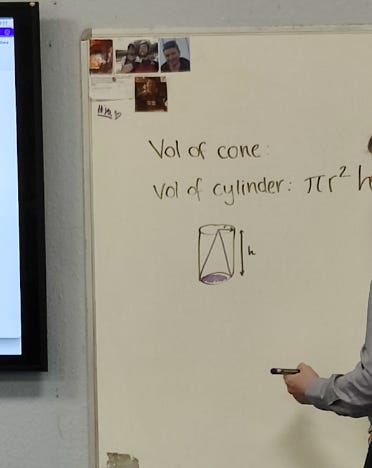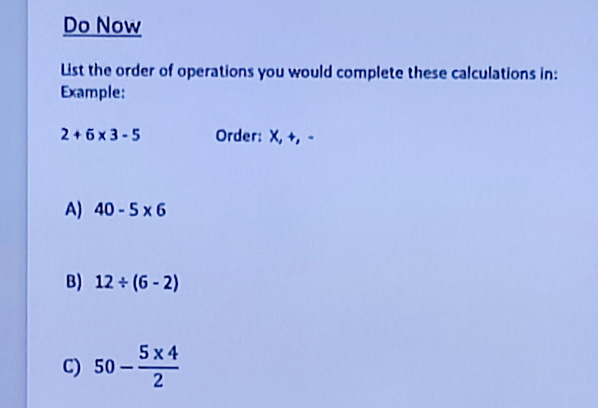Hello!
I hope you are all well.
I had a really positive response to a previous newsletter reflecting on some of the coaching sessions I have been doing with maths teachers, so I thought I would share two more case studies from the schools and teachers I have been lucky enough to work with over the last few weeks.
Case Study #1
One colleague wanted to work on his modelling, and I joined the lesson at the point he was about to explain the relationships between the volume of a cone and the volume of a cylinder.
The explanation itself was brilliant. Really clear and really concise.
But I formed a hypothesis: the students did not know what they were supposed to be doing during this explanation. Should they be watching and listening, or should they also be trying to copy down the working out from the board?
I took some pictures of the class to illustrate that at least half of the students were attempting to copy whilst listening. Not only is listening whilst writing really tricky, but the moments where students had their heads down writing meant that they missed the really important gesturing that the teacher was doing at the board to focus attention on the critical part of the explanation.
In the coaching session, I was able to praise the teacher on their fantastic explanation, and then provide critical evidence in the form of the photo that not all students were benefiting from that explanation because it was not made explicitly clear what they should be doing.
This led to a nice and simple fix: before each explanation, the teacher will make it clear to students that they should be watching, listening and thinking - empty hands and eyes on the front. This will allow them to get the most from the explanation. The copying down can come later.
With this nailed, the teacher was looking forward to experimenting with my Silent Teacher approach to improve students’ focus even more during the modelling phase of the lesson.
Case Study #2
Another colleague wanted to work on his checking for understanding. I joined the lesson at the point students were attempting the Do Now starter questions:
Just before students attempted the third question, the teacher said:
"Now, be careful with this one. It may not look like there are brackets, but there is a hidden pair of brackets somewhere. See if you can spot them."
The students then wrote their answers on their mini-whiteboards and almost everyone got the answer correct. The teacher was happy that understanding was secure, and moved on to the next phase of the lesson.
My hypothesis was that they might not have been able to get the answer correct without that hint. As no time machine was available, the only way I could test this was to ask a few of the students if they would have got that question correct without the hint. Some said they would, others said they wouldn’t.
In the coaching session, we discussed the timing of hints and support. As teachers, it is our job to help our students understand and feel successful, so if we foresee where they might struggle it is very hard to resist giving them some guidance. But - and it is a big but - if we do this before a check for understanding, it invalidates our check for understanding as we have no way of knowing how secure that knowledge was before the hint.
We discussed that in future the teacher would resist the urge to give any hints before a check for understanding, see what the students know (his use of mini-whiteboards was excellent for getting a sense of whole class understanding), and then respond accordingly. If understanding is not secure, that response may be to give the exact same hint that he would have given before, or to call upon a student who has the correct answer to offer an explanation, and then check for understanding again. But if the vast majority of students get the answer correct, the teacher has more evidence of how secure understanding is than if that success follows a hint.
If you find these reflections useful, let me know and I will keep writing them!
You can find out more about my coaching and CPD here. Adam Boxer and I discussed our processes for observing lessons and giving feedback in this podcast here.
If you found this newsletter useful, subscribe (for free!), share it with one of your colleagues, or let me know your thoughts by leaving a comment. And if you have any questions, just hit reply!
Thanks so much for taking the time to read this
Craig





